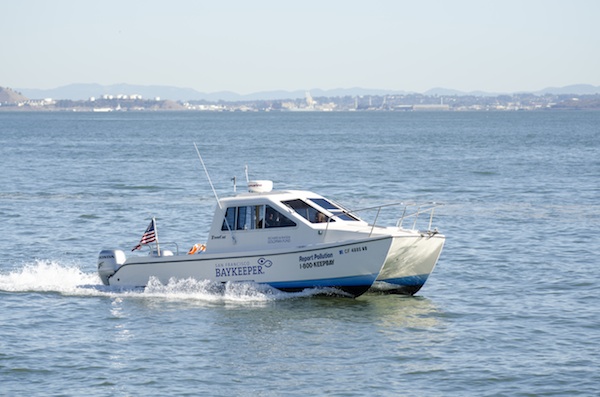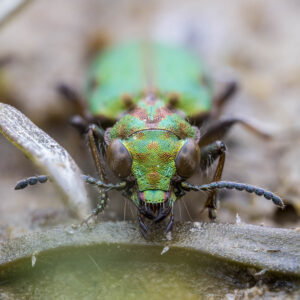
Are you originally from the Bay Area? If not, what brought you here?
I was born and raised in Atlanta, GA and attended Emory University. Then I moved to California to attend law school at UC Berkeley, and I couldn’t leave. There was no comparison between the two places — the culture, the interesting people, the weather, the amazing outdoor experiences, the beautiful Bay — California quickly became home.
Tell us about SF Baykeeper. What is it, and what are some of the main projects/campaigns you’re working on now?
San Francisco Baykeeper is a pollution watchdog for the Bay. We’ve been on the water protecting the Bay for 25 years. I joined the organization straight out of law school and fell in love with its single-minded mission to protect the Bay.
The great thing about us is that we are really small but we win. We use all the tools at our disposal (science, observation, advocacy, litigation, public education, legislation) and leverage our many partnerships to ensure that we achieve our goal or at least move the needle significantly in the direction of an imminent win for the Bay.
Tell us about some of those wins.
We’ve secured the nation’s first regulation of farm runoff, the first regulation of invasive species from ships’ ballast water, the first regulation of aquatic pesticide applications. We’ve also succeeded in strengthening laws to reduce toxic mercury pollution so the Bay-Delta is safer for fishing. We’ve also reduced harmful sewage spills from 20 cities around the Bay by more than 75 percent, making our water safer for swimming, and reduced industrial pollution and heavy metals from 25 industrial facilities along the Bay shore.
And your current projects?
We’re currently working on some very exciting and cutting-edge cases. They include protecting the sand on the Bay floor so that it can provide beneficial habitat for important species like Dungeness crab and sturgeon, and so that it can naturally leave the Bay and replenish the coastal shoreline. Over the last 70 years private sand mining in the Bay has been permitted at unsustainable rates. This has caused significant problems for the Bay ecosystem and erosion at Ocean Beach. We have a number of agency and court actions right now that are challenging the rates of sand mining and pushing for reduced levels of the practice.
Another interesting current case is our work to reduce municipal stormwater pollution, including trash and bacteria from the City of San Jose — currently one of the most significant sources of pollutants to Coyote Creek and the Guadalupe River, two large tributaries to the South Bay. We hope our work on the issue can raise awareness about the problem of trash and bacteria in municipal runoff and encourage the City to prioritize solutions to stormwater pollution.
The “mystery goo”affecting waterfowl in the Bay has been in the news lately. What is SF Baykeeper doing about this crisis?
Baykeeper joined the bird rescue and recovery efforts of International Bird Rescue and Wildlife Emergency Services as soon as we heard they needed help. Our role has been to help recruit and coordinate citizen volunteers charged with finding distressed birds along the shoreline. We’ve also been raising awareness about the inadequate government agency response due to the statutory restriction that they can only get funding when the toxic substance in question is oil-based.
When do you think the public will find out what the mystery goo is, and what effects it’s having on the Bay’s health?
It’s surprising that it’s taking the agency labs so long to identify the substance. On the other hand, there are over 100,000 industrial chemicals used in the US, many of which are not regulated, so the fact that it’s taking so long may mean that it is not an obvious suspect like an oil or a pesticide compound. Since we have little idea what it is right now, it’s hard to tell what effects it could be having on the Bay. If the reason we can’t find evidence of the substance on the water or shoreline is because the goo is sinking, for example, then down the road we may discover harmful impacts to the entire ecosystem along the Bay floor.
What is your role at SF Baykeeper, and what does a typical day look like for you?
I’m the Program Director for the organization. I wear lots of hats, but my main role is to help provide strategic leadership on our policy and litigation priorities to reduce the top pollution threats to the Bay. My typical day is spent in meetings with staff, regulators, organizational partners, and decision-makers; developing relationships that will help our mission to protect the Bay; and reviewing legal documents, communications and proposals by our legal, policy and science teams.
Are you out on the water a lot?
The Baykeeper boat goes out on patrol at least once a week with the help of eight long-time volunteer skippers. When we were a staff of three, I used to get to go out often, but that was about ten years and two kids ago!
What can people do if it they see something polluting the water?
They should report it to the appropriate agency — depending on the location and type of spill, that could be a port, marina, city or the Department of Fish and Wildlife. If you’re unsure who to call, you can always call Baykeeper’s pollution hotline: 1-800-KeepBay (533-7229) and we can investigate, alert the appropriate authorities, and follow up to ensure that action is taken.
What do you need most in terms of volunteer help right now?
Right now we need office volunteers to help us unpack and settle into our new office in Oakland! We are also currently in need of a skilled IT volunteer — someone who can update our website and protect our computers from viruses while our staff focuses on protecting the Bay. Usually our volunteer tasks include researching law, policy, and science to reduce pollution; helping with social media communications; doing administrative tasks; taking storm water samples at industrial facilities when it rains; and piloting our boat patrols.
What’s your favorite place to relax on the Bay – or overlooking the Bay?
One of my favorite places around the Bay is the Berkeley Marina. The Bay views are exhilarating, the air is refreshing, and on sunny days I enjoy flying kites there with my kids.





